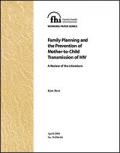Publications - Released in 2004
Mother-to-child transmission is the main way children become infected with human immunodeficiency virus (HIV) worldwide. To date, the primary approach to the prevention of mother-to child transmission (PMTCT) has been to identify HIV-infected pregnant women by voluntary counseling and testing (VCT) for HIV and then provide antiretroviral (ARV) drug prophylaxis to them during delivery and then to their newborn infants. Many HIV-positive births could be prevented, however, by simply preventing unintended pregnancies among infected women. Furthermore, increasing contraceptive use to prevent such pregnancies appears to be at least as cost-effective as providing nevirapine to HIV-infected mothers.
Minimizing HIV-positive births likely will be best achieved through a combination of various approaches, including the prevention of HIV infection among women of reproductive age. The degree to which any one approach should be emphasized will depend on factors unique to particular settings, such as HIV prevalence, client needs, and service-delivery capacity.
Downloads
Organizations
- FHI 360 (Family Health International)






